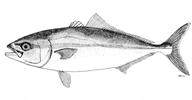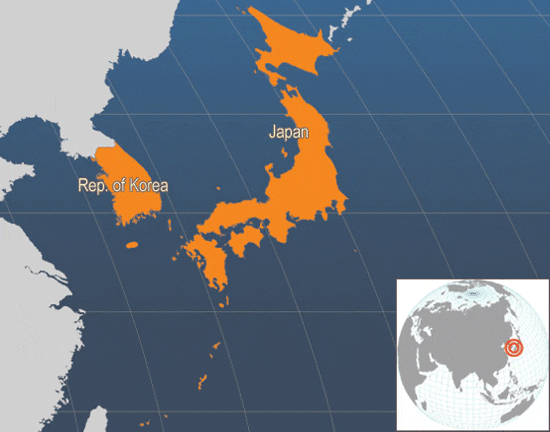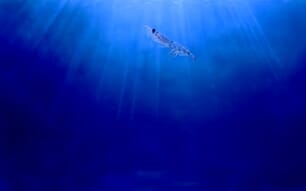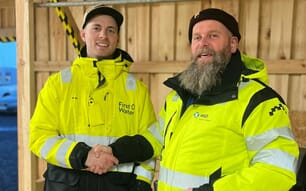Identity
Seriola quinqueradiata (Temminck & Schlegel,, 1845)
FAO Names: En - Japanese amberjack, Fr - Sériole du Japon, Es - Medregal del Japón
Biological Features

Body elongated, somewhat compressed, and without scutes on lateral line. Dorso-posterior corner of maxillary angular. Pectoral fin almost same length as pelvic fin. Body with longitudinal yellow stripe. Bears two free spines in front of the anal fin. Anal fin is shorter than the weak dorsal fin, whereas the short spines of the first dorsal fin are not free, but interconnected by a membrane. Fast swimming pelagic carnivorous fish, feeding by day on smaller fish, such as mackerels, horse-mackerels, sardines and squids.
Profile
Historical Background
Japanese amberjack culture has a long history, having begun in 1927 in the Kagawa prefecture of Japan when wild caught juvenile amberjacks were first reared in shore enclosures. Over time, this type of culture became obsolete, due to problems related to poor water quality and excessive waste accumulation within the system. Commercial production of Japanese amberjack began in the 1940s, and production began to expand rapidly in the 1960s, exceeding 43 000 tonnes by 1970. By 1995 it had reached a peak of nearly 170 000 tonnes but ranged between 139 000 and 162 000 between 1996 and 2003; no further growth trend is apparent. However, it is important to note that fish farmers have been able to maintain total production level at these significant levels despite a fall in the number of wild caught juveniles (mojako).
Japanese amberjack features in the fisheries of the Western Central Pacific Ocean, from Japan and the eastern Korean Peninsular to the Hawaiian Islands but its farming occurs mostly in Japan, the Republic of Korea being the only other country reporting production to FAO. In Japan this species is the most cultured fish, its meat being relished as sashimi. The aquaculture production of Seriola quinqueradiata constituted about 57 percent of the total farmed marine finfish production in Japan in 2003.
Main Producer Countries

Habitat and biology
Japanese amberjack is endemic to Japan and adjacent areas. It spawns along the 200 m contour in the East China Sea; juveniles migrate north to near Hokkaido, feeding for three to five years until reaching sexual maturity; then they migrate south for spawning. Adults of 70-80 cm SL approach the western coast of Kochi prefecture, Japan in March-April. From season to season, various sizes can be caught in different parts of Japan; therefore, special names are given to them in different regions. The common name of Japanese amberjacks varies with size. In Japan, those that are <50 g are called mojako, those between that and 5 000 g named hamachi, and those >5 000 g termed buri. This species is highly piscivorous species and, in the fisheries, reaches a maximum size of 150 cm TL and 40 kg. In nature, it feeds on microorganisms and small fishes while drifting north with the seaweed. Small mojako (4 to 5 mm) stay under or inside floating seaweed; larger fish (0.5 to 2 cm) swim below the surface. After reaching a size of 10 to 14 cm, they disperse from the floating seaweed and swim towards the shore. The optimum rearing water temperature for Japanese amberjack is 20-29 ºC and the optimum salinity is 30-36‰.
Production
Production Cycle

Production Systems
Seed Supply
Aquaculture of amberjack is primarily dependent on seed supply from wild. Soon after spawning, larvae less than 15 mm long are brought near the coast by the Kuroshio Current, where they are caught in fine mesh nets, and sold to fry specialists. Wild seed is also imported from other countries, such as the Republic of Korea and Viet Nam. Although artificial propagation of Japanese amberjacks has been successful, the number of juveniles produced through induced breeding has not reached a level where it can make a significant contribution to the demand of juveniles for aquaculture. In fact, there remain some problems in larval rearing: feeding is particularly critical, as imbalanced larval feed has leads to heavy mortalities. Efforts are being made to improve this situation. The design of suitable larval feed by using mass-produced food organisms, such as rotifers and brine shrimp nauplii fortified with n-3 highly unsaturated fatty acids (HUFA) and formulated feeds may soon make the production of healthy fry in large numbers possible.
Nursery
Wild caught Japanese amberjack juveniles (<10 g), are reared in 5x5x5 m net pens and sold to growers when the fish have grown to 50-100 g. The first task of the fry specialists is to grade the larvae into small, medium, and large categories; a failure to grade early can result in high mortality from cannibalism. After grading, the larvae are stocked into floating nylon net-pens. In 5 x 5 x 5 m net pens the stocking rate of 0.5-10 g mojako ranges from 10 000 to 30 000 and the harvest size ranges from 20-200 g with average survival of 90 percent. It is important to feed wild caught juveniles with good quality feed while the fish are on the collecting boat, to avoid growth related problems in the late grow-out phase; weak individuals are eliminated. Small juvenile amberjacks are sensitive to feed deprivation, and a prolonged fasting period before first feeding in net pens has a negative effect on subsequent growth rate.
Ongrowing Techniques
Commercial Japanese amberjack culture occurs in sea cages made of nylon netting or metal. The net-pen culture system is the most prevalent culture system at present and the use of net-pens with a steel frame facilitates harvesting and, is therefore being widely adapted throughout Japan. Net-pens without steel frames are inexpensive and strong enough to withstand severe tides and typhoons, but harvesting operations are difficult and time consuming. The size and number of cages varies, depending upon the size of the operation and environmental conditions. A relatively small-scale production site may have five cages of 10 x 10 x 8 m, while a relatively larger production site may often have more than 20 cages of 18 x 22 x 8 m or 12 x 12 x 12 m. As net-pen culture developed, increasingly larger pens were used, and the frames changed from wood to metal and reinforced plastics. Even larger pens, up to 50 x 50 x 50 m are in use, particularly to grow larger size amberjack. This provides them with enough space for exercise, helping them build firm muscle; larger net pens are desirable to produce high-quality meat with the correct fat level (both low and high fat levels are regarded as unsuitable for the production of sashimi - the best level would be about 10 percent). Net-pen culture requires frequent net exchange because of the biofouling that restricts water exchange.
Japanese amberjack show rapid growth in net-pens. Stocking densities vary with the type of culture system and the grow-out stage of the fish. In 8 x 8 x 8 m net-pens the stocking rate of 20-200 g juveniles ranges from 14 000 to 20 000 and the harvest size ranges from 300-1 000 g with an average survival of 95 percent. In 10 x 10 x 10 m net pens the stocking rate of 600-1 400 g fish ranges from 4 000 to 7 000 and the harvest size ranges from 3 500-6 500 g, with an average survival of 97 percent. In 10 x 10 x 10 m net pens 3-year Japanese amberjacks in the weight range 1 200-1 500 g are stocked at 3 500-5 000, the harvest size ranges from 3 500-4 000 g, and average survival is 97 percent. Despite these already good results, modifications are being made, based on the environmental conditions at each aquaculture site. A typical floating raft (30 x 30 x 15 m) can be used to rear 25 000 amberjack with an average body weight of about 2 kg. The stocking density is also dependent on cage-site conditions, such as temperature, dissolved oxygen, mesh size and water exchange rates. Depending on water temperature, mojako can usually be stocked from April through July. Fingerlings of 8-50 g stocked in June reach 1.0-1.5 kg (30-50 cm, SL) by December. The fish that are left in the cage until the following farming season reach a size of 2-3 kg.
Water temperatures vary in the areas where Japanese amberjack culture is carried out. In each region, the farmers have developed a characteristic method of rearing by considering this local factor. For young amberjack (hamachi), the ranges for economical and maximal growth are 17-30 ºC and 22-27 ºC, respectively; for adult amberjack (buri) they are 15-30 ºC and 20-26 ºC. A dissolved oxygen (DO) level of >5.7 mg/l is desirable for good growth. Growth reduction and abnormal behaviour have been reported when the DO level becomes lower than 5.7 and 4.3 mg/l, respectively.
Feed Supply
Japanese amberjack culture used to depend on locally available trash fish, such as Pacific sandeel (Ammodytes personatus), anchovy (Engraulis japonicus), chub mackerel (Scomber japonicus), sardine (Sardinops melanostictus), and Pacific saury (Cololabis saira). Japanese amberjack culture expanded due to the massive catches of the low-cost fish used for feeding, such as sand-lance and sardine around Japan. The availability of freezing equipment made it possible for the farmers to feed minced frozen sardine and supported the further development of farming. However, in recent years, there has been decline in the sardine resources caught around Japan and the cost has therefore increased. This has forced many farmers to change from feeding fish to the use of formulated feed. Formulated feed production has increased and the amount of extruded pellets is now about 40 percent of the total food used for Japanese amberjack production, on an 'as fed' basis. Feeding extruded pellets for the first year of culture during the growing season (high water temperature) is popular. However, the use of raw fish or moist pellets is still common when water temperatures are reduced (<15 ºC).
Feeding is crucially important because feed costs represent about half of the total budget of the average farmer. Using appropriate quality feed in the correct quantity is therefore very important for efficient and sustainable production. For example, feeding Japanese amberjack with sardine alone led to nutritional disorders because of unsuitable protein and energy ratios. With improved knowledge on nutritional requirements it became possible to produce moist pellets and formulated feeds for Japanese amberjacks. However, the farmers are still facing problems in culturing larger fish on extruded pellets. Larger fish (>3 kg) prefer raw fish to extruded pellets, and it is difficult to attain daily feeding rates of 2 percent on extruded pellets, especially during winter. The feeding frequency ranges from five times/day to once every 3 days, depending on body weight, growing stage, and seawater temperature. Food consumption drastically reduces at temperatures below 17 ºC, particularly when a dry diet is fed.
Harvesting Techniques
Most Japanese amberjack growers target a market size of about 2-5 kg, while some even raise the fish to 7-8 kg. The average harvest sizes are 6 kg in 19-20 months in high-temperature areas, 5-6 kg in 27 months in medium-temperature areas, and 3.5-4.5 kg in 27 months in low-temperature areas. The size at harvest and the length of the grow-out period not only varies according to the mean annual water temperature but also on the desired market size.
In order to maintain high product quality, the fish are fasted before harvesting. The main purpose of this is to evacuate the ingested feeds, as they may contribute to rapid deterioration in flesh quality. During harvest, Japanese amberjacks are collected from the net cage by scooping with nets attached to long steel pipes at both sides. Fish that have been scooped up in the canvas net are released onto a selection stand, where they are size-graded and counted.
Handling and Processing
Japanese amberjacks are slaughtered individually on a soft rubber mat instantly after harvest. The fish are then packed in corrugated boxes under ice or dumped into a tank with a large amount of chipped ice before the harvested fish are transported in individual containers on refrigerated trucks. To maintain freshness for a longer period, the fish are killed immediately after being taken from the water and completely bled. Recently, consumers have shown greater interest in fresh fish and are ready to pay higher prices for premium products. Consequently, there is growing business interest among Japanese amberjack producers to supply fresh fish directly to the end-users, avoiding the complicated wholesale network. In addition, wholesalers have developed facilities to keep live fish in holding tanks in order to supply as them as fresh as possible to restaurants and high economic class consumers on demand.
Japanese amberjack meat is mostly eaten raw as 'sashimi' and a relatively small proportion of the total production is being consumed in soups or after grilling. The meat can be served as sashimi when cold-stored for no more than three days (the actual maximum storage time depends on rearing conditions and post harvest treatments). Rapid killing, complete bleeding, filleting, and proper packaging and refrigeration leads to excellent quality product. In retail shops Japanese amberjack is mostly sold as fillets, whereas in supermarkets both whole fish as well as fillets are available.
Production Costs
In aquaculture operations fry and feed together account for the major portion of the total production costs. 5 cm Japanese amberjack fry cost between 50-100 Yen (USD 0.43-0.85) in 2005. On average, half of the total annual farm expenditure goes to feed procurement. The feed conversion rate for farmed Japanese amberjack, using raw fish is about 7-8:1. Assuming a raw fish price of 40 Yen/kg (USD 0.34/kg) and an average survival rate of 80-90 percent, fry and feed costs total about 400 Yen/kg (USD 3.41/kg) of cultured fish. The market price of Japanese amberjack fluctuates widely, depending on the availability of captured fish, and is also dependent on harvest size. Generally, wild-caught fish fetch more than farmed fish and the larger fish fetch a higher market price. Usually, Japanese amberjack cultured for one season (0.8-1.2 kg) fetch 500 Yen/kg (USD 4.27); those cultured for 2 years (3.0-4.0 kg) fetch 650 Yen/kg (USD 5.54); and those that are 3 years old (7-8 kg) fetch 800 Yen/kg (USD 6.82) - all 2005 prices.
Diseases and Control Measures
The major disease problems affecting Japanese amberjack are included in the table below.
In some cases antibiotics and other pharmaceuticals have been used in treatment but their inclusion in this table does not imply an FAO recommendation.
| Disease | Agent | Type | Syndrome | Measures |
|---|---|---|---|---|
| Iridovirus infection. Also known as Viral Splenic Virus (VSN) | Virus | Abnormally hypertrophic cells in the spleen | Exclude potentially infected fish | |
| Pancreatic-hepatic necrosis of amberjack. Also known as Yellowtail Ascite Virus (YAV) | Virus | Moribund fry show anaemic gills; haemorrhaging in the liver; ascites; and petechiae in the pyloric caeca | IExclude potentially infected fish | |
| Vibriosis | Vibrio anguillarum | Bacterium | Progressive reddening of fins and skin; skin ulceration; extensive muscular necrosis; internal haemorrhaging; reduced activity | Oral administration of sulfa drugs or antibiotics; limiting densities in cages; daily surveillance during feeding; keeping the fish well fed and in good condition |
| Pseudotuberculosis | Pasteurella piscicida | Bacterium | Formation of white nodes on the internal organs (spleen, kidney); during mild outbreaks, these symptoms may not appear; can be diagnosed using commercially available diagnostic kits when suspected | Oral administration of antibiotics; due to high risk involved with outbreak of this disease growers used to administer prophylactic doses of medication |
| Streptococcus infection | Streptococcus sp | Bacteria | Bleeding inside the gills; sores on the fins; ulcers on the base of the tail | Oral administration of antibiotics; limiting densities in cages; supplying good quality feed; avoiding over-feeding; prompt removal of infected fish |
| Nocardia | Nocardia kampachi | Bacterium | Swollen lesions and ulcers on body surface; nodules sometimes present on gillsl | Control restricted to avoiding introduction of infected fish or fish products |
| Fungal infection | Ichthyosporidium sp. | Fungi | Affects circulation system and some other organs of the fish; clinical signs seen only when infection is well established, which may include change of appearance, deformity, emaciation, colour changes and loss of balance | No effective treatment, although a combination of oral and in-water medication with 2-phenoxyethanol has been recommended; prompt removal of infected fish; stop feeding raw fish or raw fish based products |
| Flatworm infection | Bendenia seriolae | Trematode | Attaches to skin; at the site of attachment fish secrete viscous fluid and develop a sore as the fish rub the site against the side of the pen; skin peels off, exposing the flesh | Prevented by dipping the stock in freshwater for 5 min, every 10-14 days or by dipping the stock in aerated seawater containing 500 ppm hydrogen peroxide for 5-7 min |
| Trematode infection | Axine heterocerca | Trematode | Found in the gills, which may cause a fatal anaemia | Cured with various drugs or by placing the fish in strong salt water (100 ‰) for 2 to 4 min |
In general, to prevent disease it is necessary for Japanese amberjack farmers to maintain a healthy environment and, based on their experience, predict when and what kind of disease might be anticipated under existing conditions. If conditions indicate the potential for a disease epizootic, stocking density can be reduced and feeding can be curtailed. The removal of dead fish is the first step in the prevention of further spread of disease. Both sick and dead fish should be removed from the affected pens. Farms become more vigilant when water temperature rises above 28 ºC as Japanese amberjacks are more vulnerable to infectious diseases under such conditions.
Suppliers of pathology expertise
Advice and technical assistance on Japanese amberjack pathology can be obtained from:
- Professor Kenji Kawai, Fish Disease Laboratory, Faculty of Agriculture, Kochi University, Japan.
Statistics
Production Statistics

(FAO Fishery Statistic)
In 2004, the output of Japanese amberjack was just over 150 000 tonnes, with a minor amount (45 tonnes) being produced in the Republic of Korea. Total production reached a peak of nearly 170 000 tonnes in 1995 but, since then has fluctuated between a low of 137 000 tonnes in 2000 and a high of 163 000 tonnes in 2002. The global value of Japanese amberjack farming in 2004 was USD 1 276 billion. Recently and currently, Japanese amberjack aquaculture is severely constrained by the increase in production costs, due to increases in juvenile and feed prices. However, despite a reduction in the number of farms, the total level of production has not fundamentally changed in recent years, suggesting that intensification is underway.
Market and Trade
The market for cultured Japanese amberjack can be divided mainly into three categories: demand from high-class Japanese restaurants that deal mainly with live fish; wholesale stores and supermarkets dealing with fresh and frozen fish; and direct delivery of processed fillets to individual restaurants and homes. Direct delivery from the producer to the consumer is a recent development and the business is gaining momentum. Consumers now recognize differences in product quality, so this type of delivery system has a promising future and could help to stabilize the level of fish farming.
Between 1995 and 2005 the profitability of amberjack farming has declined, due to the low market price of the product. In addition, the contribution of juvenile costs to the total expenditure has increased. Feed costs are also increasing because of declining sardine resources around Japan.
Status and Trends
Though Japanese amberjack aquaculture is a well established practice, its development has reached stagnation, as is apparent from the annual production data, which seem to have reached a plateau. A fall in the number of wild caught seed and the decline in wild caught sardines as feed resources have led to increased production costs, whereas the value of the farmed product has decreased due to a sluggish market. The total number of farms rearing this species in Japan has declined substantially and many farms are trying to diversify their activities by culturing more than one species to reduce the risk of economic loss due to over-reliance on Japanese amberjack. However, the production of large number of artificially propagated juveniles will reduce the pressure on the wild stock and may lead to the availability of good quality juveniles at lower price; this may contribute to an expansion in Japanese amberjack farming.
For the sustainable development of amberjack farming it is of foremost importance to reduce production costs. The mass production of artificially propagated juveniles and reducing the cost of formulated feed are the two most urgently required actions to towards this goal. Research programmes dedicated to the production of better quality juveniles that show good growth rates and less vulnerability to diseases through selective breeding also need attention. Feed research should evaluate the use of inexpensive feed materials, such as plant proteins instead of fish meal, as the farmers are having difficulty in making a profit due to high formulated feed costs. In addition, the development of suitable artificial diets for the final phase of amberjack culture and appropriate feeding techniques to grow large Japanese amberjacks needs immediate attention.
Main Issues
The major issues are:
- The reducing trend of Japanese amberjack consumption, particularly among young Japanese has led to drop in market prices. Prices have been decreasing since 1995 and there has been a 40 percent decrease in the number of farm in 20 years.
- Feed costs are increasing because of a dramatic decline in the sardine resources around Japan.
- Thus increased production costs, coupled with a sluggish market value for cultured Japanese amberjack, have led to reduced profitability.
- High-density culture is becoming common practice to compensate for falling profits; however, this may cause pollution of the rearing areas.
- The number of wild caught juveniles has decreased gradually; consequently, their unit cost and the proportion of their contribution to total expenditure dedicated have increased.
- Though artificial propagation has been successful, there remains a bottleneck in the larval rearing of this species; immediate attention is required to develop an efficient, cost-effective larval rearing technique. If this is successful, the greater availability of artificially propagated juveniles may lead to an expansion in Japanese amberjack farming in the future.
Responsible Aquaculture Practices
Best management practice includes maintaining daily records of fish health, feeding activity, and environmental quality. Overfeeding must be avoided as it results in unhealthy fish and poor quality meat. Also, overfeeding pollutes the grow-out areas and can promote the occurrence of red tide outbreaks that can result in mass mortality.
In order to alleviate environmental problems the Japanese amberjack aquaculture industry needs to take some strict measures, such as prohibiting the culture of large fish grown solely on raw fish, a practice that is environmentally detrimental.
Finally, the refinement of two promising technologies, the rearing of artificially propagated larvae and the development of a suitable extruded pellet diet for large fish (and the encouragement and successful adoption of these techniques) holds the key for sustained growth of Japanese amberjack aquaculture in Japan.
Responsible aquaculture at the production level should be practised in accordance with the main principles of environmental and ecological protection - see Article 9 of the FAO Code of Conduct for Responsible Fisheries.
October 2010




